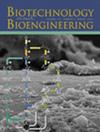Magnetic‐Assisted Manipulation of Rare Blood Cells for Diagnosis: A Systematic Review
IF 3.5
2区 生物学
Q2 BIOTECHNOLOGY & APPLIED MICROBIOLOGY
引用次数: 0
Abstract
The precise isolation and analysis of rare cells from blood are crucial for biomedical research and clinical diagnostics. This review examines recent advancements in magnetic‐based separation techniques, focusing on their efficiency in capturing rare cells such as circulating tumor cells (CTCs), circulating fetal cells, and diseased red blood cells (RBCs). These methods use magnetophoresis under external magnetic fields for highly specific isolation with minimal contamination, offering advantages over traditional techniques in speed, cost‐effectiveness, and robustness. Magnetic separation is categorized into label‐based methods, which use immunomagnetic nanoparticles (IMNs) to target specific cell markers, and label‐free methods, which exploit differences in magnetic susceptibility. Both approaches have achieved up to 99% efficiency in isolating diseased RBCs and CTCs. However, challenges remain in improving purity, scalability, and clinical applicability. A key limitation of label‐based methods is the need to detach cells from magnetic beads without compromising viability. Label‐free technologies, such as magnetic levitation, enable ligand‐free separation based on density and susceptibility. Future research should focus on optimizing paramagnetic media, integrating machine learning for enhanced accuracy, and developing high‐gradient magnetic fields (~1000 T/m) to improve efficiency. Advancements in IMNs with stronger magnetic properties will further enhance separation performance, driving clinical translation.磁辅助操作用于诊断的罕见血细胞:系统综述
从血液中精确分离和分析稀有细胞对生物医学研究和临床诊断至关重要。本文综述了磁基分离技术的最新进展,重点介绍了磁基分离技术在捕获稀有细胞(如循环肿瘤细胞、循环胎儿细胞和病变红细胞)方面的效率。这些方法在外部磁场下使用磁泳术进行高度特异性的分离,污染最小,在速度、成本效益和稳健性方面优于传统技术。磁分离分为基于标记的方法和无标记的方法,前者使用免疫磁性纳米颗粒(IMNs)靶向特定的细胞标记物,后者利用磁化率的差异。这两种方法在分离患病红细胞和ctc方面的效率都达到了99%。然而,在提高纯度、可扩展性和临床适用性方面仍然存在挑战。基于标签的方法的一个关键限制是需要在不影响生存能力的情况下从磁珠上分离细胞。无标签技术,如磁悬浮,实现了基于密度和磁化率的无配体分离。未来的研究应该集中在优化顺磁介质,集成机器学习以提高精度,以及开发高梯度磁场(~1000 T/m)以提高效率。具有更强磁性的imn的进步将进一步提高分离性能,推动临床转化。
本文章由计算机程序翻译,如有差异,请以英文原文为准。
求助全文
约1分钟内获得全文
求助全文
来源期刊

Biotechnology and Bioengineering
工程技术-生物工程与应用微生物
CiteScore
7.90
自引率
5.30%
发文量
280
审稿时长
2.1 months
期刊介绍:
Biotechnology & Bioengineering publishes Perspectives, Articles, Reviews, Mini-Reviews, and Communications to the Editor that embrace all aspects of biotechnology. These include:
-Enzyme systems and their applications, including enzyme reactors, purification, and applied aspects of protein engineering
-Animal-cell biotechnology, including media development
-Applied aspects of cellular physiology, metabolism, and energetics
-Biocatalysis and applied enzymology, including enzyme reactors, protein engineering, and nanobiotechnology
-Biothermodynamics
-Biofuels, including biomass and renewable resource engineering
-Biomaterials, including delivery systems and materials for tissue engineering
-Bioprocess engineering, including kinetics and modeling of biological systems, transport phenomena in bioreactors, bioreactor design, monitoring, and control
-Biosensors and instrumentation
-Computational and systems biology, including bioinformatics and genomic/proteomic studies
-Environmental biotechnology, including biofilms, algal systems, and bioremediation
-Metabolic and cellular engineering
-Plant-cell biotechnology
-Spectroscopic and other analytical techniques for biotechnological applications
-Synthetic biology
-Tissue engineering, stem-cell bioengineering, regenerative medicine, gene therapy and delivery systems
The editors will consider papers for publication based on novelty, their immediate or future impact on biotechnological processes, and their contribution to the advancement of biochemical engineering science. Submission of papers dealing with routine aspects of bioprocessing, description of established equipment, and routine applications of established methodologies (e.g., control strategies, modeling, experimental methods) is discouraged. Theoretical papers will be judged based on the novelty of the approach and their potential impact, or on their novel capability to predict and elucidate experimental observations.
 求助内容:
求助内容: 应助结果提醒方式:
应助结果提醒方式:


